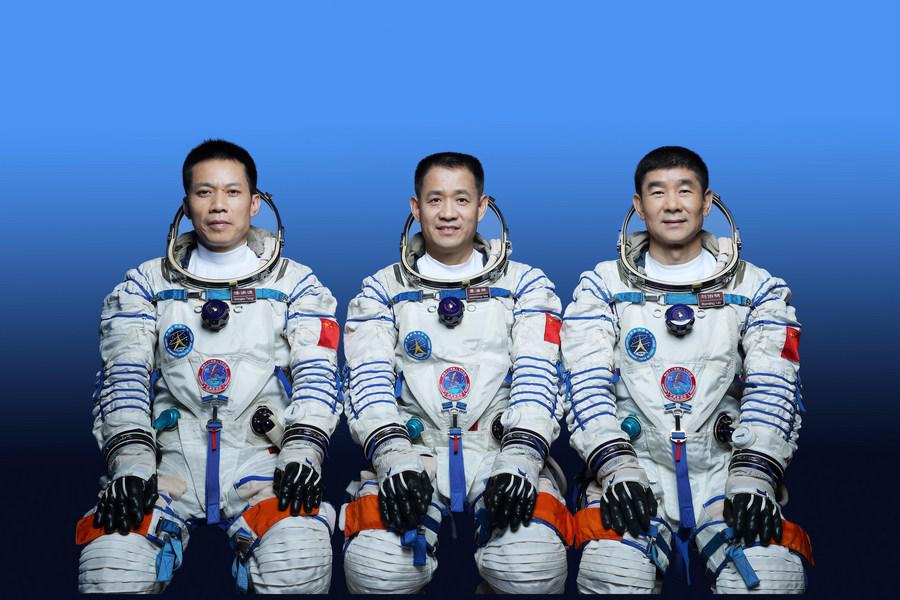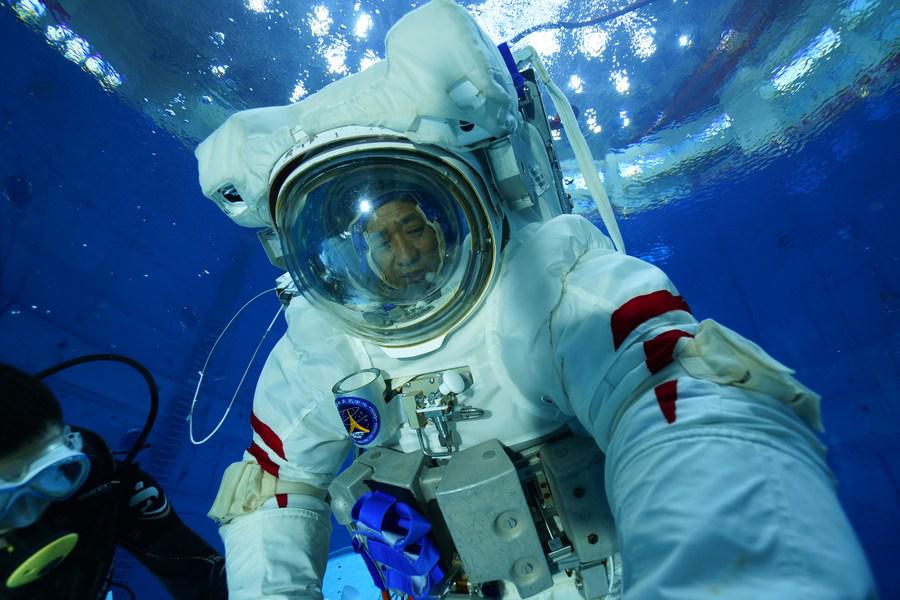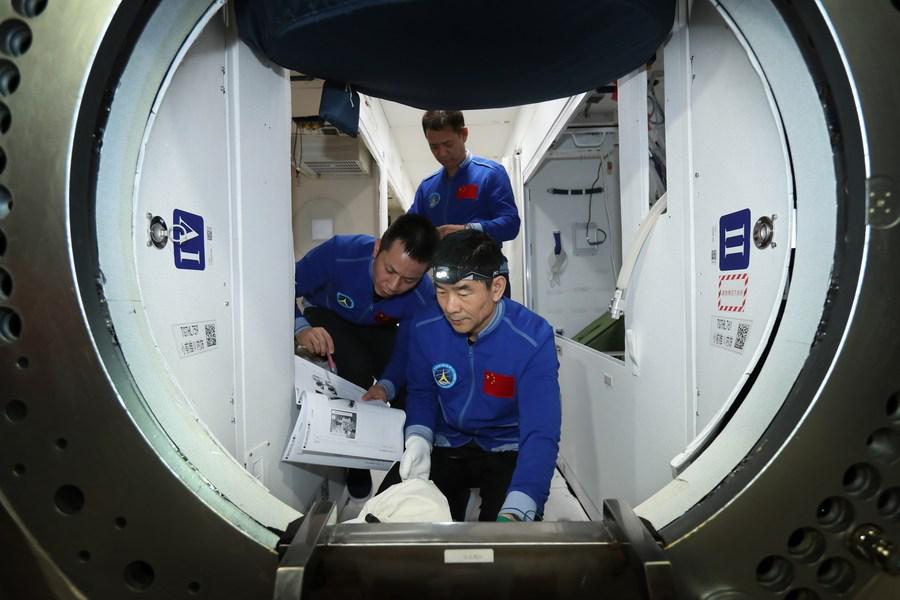Chinese astronauts ready for in-orbit space station construction
-- Nie Haisheng, Liu Boming and Tang Hongbo, the first Chinese astronauts to live and work in the country's space station currently under construction, made their public debut as a crew on Wednesday.
-- The Shenzhou-12 spaceship is expected to be launched on Thursday morning from the Jiuquan Satellite Launch Center. It will later dock with the in-orbit space station core module Tianhe, forming a complex with Tianhe and the cargo craft Tianzhou-2.
-- This will be the first manned mission during the construction of China's space station, with aims to conduct in-orbit verification of technologies concerning the astronauts' long-term stay and health care, recycling and life support system, supply of space materials, extravehicular activities and operations, as well as in-orbit maintenance.
JIUQUAN, June 16 (Xinhua) -- Nie Haisheng, Liu Boming and Tang Hongbo, the first Chinese astronauts to live and work in the country's space station currently under construction, made their public debut as a crew on Wednesday at the Jiuquan Satellite Launch Center.
The trio will carry out the Shenzhou-12 manned spaceflight mission, and Nie will be the commander, Ji Qiming, assistant to the director of the China Manned Space Agency (CMSA), announced earlier on Wednesday.

Chinese astronauts Nie Haisheng (C), Liu Boming (R) and Tang Hongbo will carry out the Shenzhou-12 manned spaceflight mission. (Photo by Xu Bu/Xinhua)
The Shenzhou-12 spaceship is expected to be launched on Thursday morning from the launch center in northwest China. It will later dock with the in-orbit space station core module Tianhe, forming a complex with Tianhe and the cargo craft Tianzhou-2. The astronauts will then be stationed in the core module and remain in orbit for three months.
This will be the first manned mission during the construction of China's space station, with aims to conduct in-orbit verification of technologies concerning the astronauts' long-term stay and health care, recycling and life support system, supply of space materials, extravehicular activities and operations, as well as in-orbit maintenance, Ji said.
Nie, the most experienced among the three, was in the Shenzhou-6 mission in 2005 and the Shenzhou-10 mission in 2013.
It will be Liu's second spaceflight, as he once participated in the Shenzhou-7 mission in 2008, which featured a landmark spacewalk.
Tang will be a newcomer to space. He became a member of the second batch of Chinese astronauts in 2010.
Zhai Zhigang, Wang Yaping and Ye Guangfu will be the backup crew, Ji said.
China launched Tianhe on April 29 and Tianzhou-2 on May 29. The two completed a computer-orchestrated rendezvous and docking on May 30, waiting for the first crewed mission to unpack the cargo.
CREW'S EXPECTATIONS
"We are honored to take the lead in a series of manned missions for the space station construction, and we have many expectations," Nie said at a press conference held at Wentiange, or "Ask-the-Sky Pavilion", at the launch center on Wednesday.

Chinese astronauts Nie Haisheng (C), Liu Boming (R) and Tang Hongbo meet the press at the Jiuquan Satellite Launch Center in northwest China, June 16, 2021. (Xinhua/Ju Zhenhua)
"Our upcoming mission will take longer than before. We will not only make the core module a 'space home,' but also carry out a series of key technology verifications. There will be more arduous tasks and more challenges."
"Every stride we take will represent the courage and persistence of mankind in exploring space, and contribute Chinese wisdom and strength to the peaceful use of outer space," he added.
It has been 13 years since Liu participated in the Shenzhou-7 mission. He has been dedicated to training and maintained high expectations for his new mission.
"We have carried out strict, systematic and comprehensive training to ensure each extravehicular activity is completed well, especially under the protection of the new-generation extravehicular spacesuit," Liu said.
Tang acknowledged that pressure is inevitable since it will be his first spaceflight mission. "But I believe that pressure builds up motivation and confidence guarantees success. After 11 years of learning, training and testing, I am full of confidence in myself and our team," Tang said.
He said he hopes to meet and work with astronauts from other countries in the space station in the future.
TOUGHER TASKS
The Shenzhou-12 astronauts are expected to set a new record for China's manned space mission duration and their work is also more complicated and challenging than previous crewed missions, said CMSA director Hao Chun.
According to Ji, in the Shenzhou-12 mission, the crew will complete four major tasks in orbit.

Chinese astronaut Nie Haisheng carries out underwater training on Jan. 2, 2021. (Photo by Kong Fangzhou/Xinhua)
First, they will operate and manage the complex, including the in-orbit test of the Tianhe module, verification of the recycling and life support system, testing and operation training of the robotic arm, as well as management of materials and waste.
Second, they will move, assemble and test extravehicular spacesuits and perform two extravehicular activities for work including assembling an extravehicular toolbox, lifting the panoramic camera and installing extended pump sets.
Third, they will carry out space science experiments and technology experiments, as well as public outreach activities.
Fourth, they will manage their own health through daily life care, physical exercise, and regular monitoring and assessment of their own health status.
The astronauts have all carried out solid ground training and mission preparation under comprehensive training programs and plans, Ji said.
COLORFUL SPACE LIFE
The Tianhe module will provide the astronauts three times as much space as what was available in the Tiangong-2 space lab, with three independent bedrooms and one bathroom.
Meanwhile, the astronauts can choose from more than 120 kinds of space food that not only taste good but provide balanced nutrition with a long shelf-life.

Chinese astronauts Nie Haisheng, Liu Boming and Tang Hongbo carry out training on April 22, 2021. (Photo by Xu Bu/Xinhua)
The dining area is equipped with food heating device, refrigerator, water dispenser and folding table. In the exercise area, the treadmill and spin bike provide them exercise to maintain physical health.
The two-way video communication and e-mails between the station and ground control will be realized through the space communication link and video communication equipment.
Compared with previous crewed missions, the core module of the space station is, for the first time, equipped with a life support system, including subsystems for electrolytic oxygen generation, condensate water collection and treatment, urine treatment, carbon dioxide removal, and the removal of trace amounts of harmful gas to ensure the long-term in-orbit stay of astronauts, Ji said.
MORE EXTENSIVE COOPERATION
The space station in low-Earth orbit can carry out large-scale space science and technology experiments with astronauts involved, which can greatly promote the development of space technology and enable technological innovation in related fields, Ji said.

Chinese astronauts Nie Haisheng (C), Liu Boming (L) and Tang Hongbo carry out training on May 15, 2021. (Photo by Xu Bu/Xinhua)
Though China is relatively a latecomer in this field, its space station has complete functions and advanced technologies with a moderate scale.
It also has some outstanding advantages in terms of reliability and safety, habitability, comprehensive efficacy, compatibility, cost-efficiency as well as the information, energy and power technologies, Ji said.
China also plans to carry out more extensive and in-depth international cooperation on its space station, making it a space lab for the benefit of all mankind, Ji said.
The scientific experiment cabinets aboard China's space station have been equipped with standard ports for diversified payloads to carry out international research, he said.
The CMSA has worked with the United Nations Office for Outer Space Affairs (UNOOSA) to invite UN member states to conduct scientific experiments aboard China's space station.
In June 2019, China released the first batch of nine jointly-selected international cooperation projects, involving 17 countries in aerospace medicine, life sciences and biotechnology, microgravity physics and combustion science, astronomy, and other emerging technologies.
Ji noted that China and Russia have maintained sound and productive cooperation in the crewed spaceflight field. Both sides are maintaining exchanges in low-Earth orbit space station and crewed deep space exploration, and more cooperation is expected.
China also welcomes cooperation proposals of joint flight of Chinese and foreign astronauts, which might be realized after the construction of China's space station is completed, he said.
Photos
Related Stories
- China unveils Shenzhou-12 astronauts for space station construction
- China's first crewed space station mission draws closer
- Effective power supply energizes China's space station project
- SpaceX launches tiny critters, solar panels to space station
- China launches cargo craft for space station supply, refueling mission
Copyright © 2021 People's Daily Online. All Rights Reserved.










